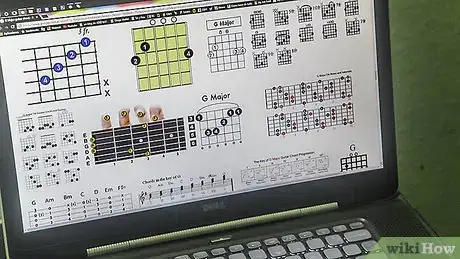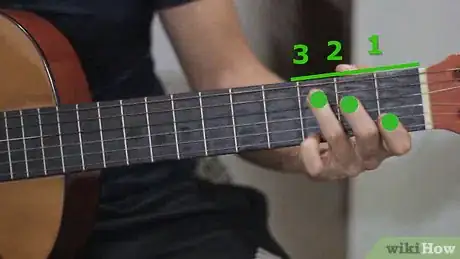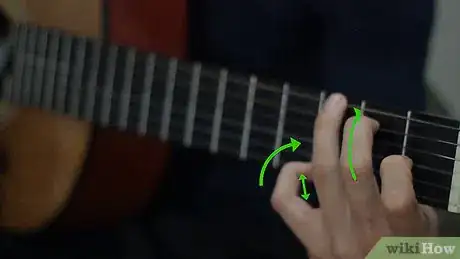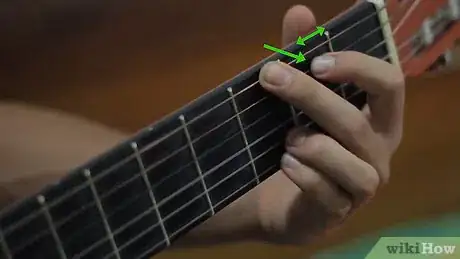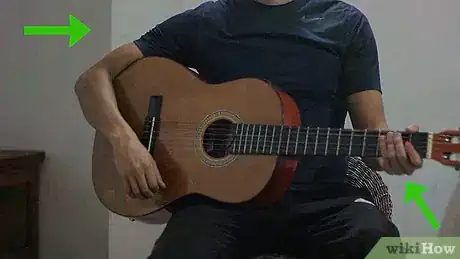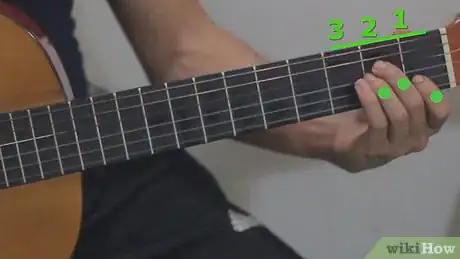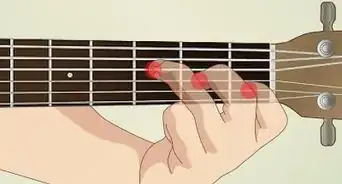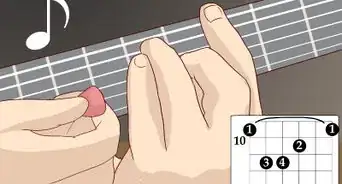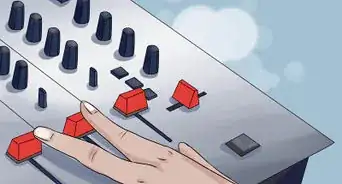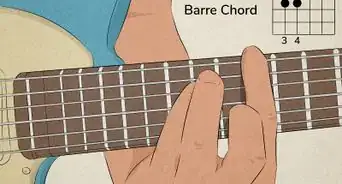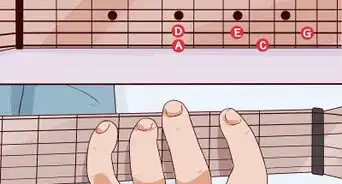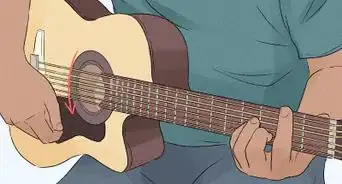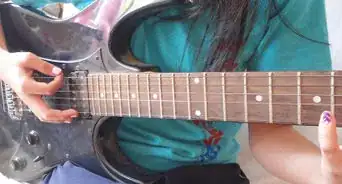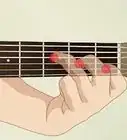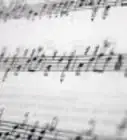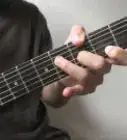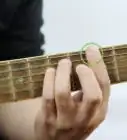This article was co-authored by Nicolas Adams and by wikiHow staff writer, Jennifer Mueller, JD. Nicolas Adams is a 5th generation musician of Serbian Gypsy descent and the lead guitarist of the band Gypsy Tribe. Based in the San Francisco Bay Area, Nicolas specializes in Rumba Flamenco and Gypsy jazz and playing the guitar, Bouzouki, Balalaika, and piano.
There are 7 references cited in this article, which can be found at the bottom of the page.
This article has been viewed 219,491 times.
If you want to learn how to play guitar, basic chords are a good place to start. There actually are thousands of playable guitar chords, so you're not necessarily going to learn how to play them all.[1] However, you can get a good start with some basic open chords that are commonly used in most popular songs you might want to play. In fact, if you know just eight open chords you should be able to play most any song. These eight chords also provide the foundation you need if you want to progress to more advanced techniques.[2]
Steps
Learning Your First Chords
-
1Memorize the names of your guitar's strings. Try a mnemonic device to help you remember the names of the strings: EADGBE. Simply make up a sentence where the first letter of each word is the name of a string.[3]
- If you're having a hard time coming up with your own sentence, you might want to use "Eat All Day Get Big Easy."
- Hold your guitar in front of you so that it's facing you and look at the strings. The thickest string on the far left is low E. The A string is next to it. The third string from the left is D, followed by the G string and the B string. Finally you have the high E string to the far right, which will be the thinnest string on your instrument.
- One thing to keep in mind is that as you're looking down at a guitar from a playing position, the lowest strings will be on the top of the instrument (if you're playing right-handed). However, when you're told to play the "top" strings, you're actually playing the thinner strings that correspond to higher notes. The "bottom" strings are the thicker strings that correspond to lower notes.
-
2Get familiar with your guitar's frets. The frets are the bars that span the neck of your guitar, spaced about an inch apart. You'll be placing your fingers along the neck of the guitar at a position just above the fret indicated.[4]
- The first fret will be about an inch down from the nut or top of the guitar neck. The second fret is about an inch below that, the third fret about an inch below that, and so on.
- Basic open chords typically only use the first three frets, so when you're just starting out that's all you need to be worried about.
Advertisement -
3Use fingerboard diagrams. Even if you know how to read music, musical notation won't tell you where to place your fingers to play chords on a guitar. Fingerboard diagrams can help you learn where to place your fingers. Find them online, or download a free mobile app.[5]
- The fingerboard diagram reads from left to right. If you hold up your guitar in front of you as you did to learn the strings, the line to the far left of the diagram is low E. The vertical lines on the diagram are the strings, while the horizontal lines are the frets.
- There will be circles on the diagram to show where your fingers should be placed. You'll see a number in the circle that corresponds to the finger that should be placed there.
- Memorize the finger numbers. Your index finger is your first finger, your middle finger is your second finger, your ring finger is your third finger, and your pinky is your fourth finger. Some more complex chords also require you to use your thumb, which is represented by a "T" on most fingerboard diagrams.
-
4Try a G major chord. The G major chord is probably one that sounds familiar, as it is the basic chord in a lot of popular songs. To finger a G major chord, put your third finger on the third fret of the low E string, your second finger on the second fret of the A string, and your fourth finger on the third fret of the high E string.[6]
- If this finger position feels uncomfortable, you can also make a G major using your first, second, and third fingers instead of your second, third, and fourth. However, keep in mind that as you progress this finger positioning may make it more difficult for you to transition quickly from G major to other chords.
- When you first place your fingers, strum each string individually. For G major, you're going to strum all six strings, even the unfretted ones. This is what makes it an open chord.
- With an open chord, each chord you strum should sound clearly. If a string sounds flat or muted, check your finger positioning. You should put the tip of your finger on the string to press it down, but your finger shouldn't touch any other strings.
EXPERT TIPRon Bautista is a professional guitarist and guitar teacher at More Music in Santa Cruz, California and the Los Gatos School of Music in Los Gatos, California. He has played guitar for over 30 years and has taught music for over 15 years. He teaches Jazz, Rock, Fusion, Blues, Fingerpicking, and Bluegrass.Professional Guitarist & Guitar Instructor
 Ron Bautista
Ron Bautista
Professional Guitarist & Guitar InstructorThe difference between a chord and an arpeggio is how you play the notes. An arpeggio is a separated chord, and a chord is where you play the arpeggio notes at the same time.
-
5Move on to C major. To make a C major chord, put your first finger on the first fret of the B string, your second finger on the second fret of the D string, and your third finger on the third fret of the A string.[7]
- Notice that the finger numbers correspond to the fret numbers. That makes C major a pretty easy chord to remember.
- When you strum a C major, you want to stick to the top five strings – don't strum the low E. Since you're used to strumming all six strings with G major, this might take some practice to get right.
- Now that you know two chords, you might want to practice transitioning back and forth between them. This will help you memorize the chord shape and your hand positioning so that you can find the chords without needing to look at a fingerboard diagram.
-
6Find D major. To make a D major chord, you'll place your third finger on the third fret of the B string, your second finger on the second fret of the high E string, and your first finger on the second fret of the G string.[8]
- To strum D major, you only want to strum the top four strings. In addition to the low E string that you left out when you strummed C major, you're also leaving out the A string.
- You might want to practice transitioning back and forth between G major and D major, so you can get a better feel of which strings should be strummed.
-
7Start playing some songs. Once you're comfortable with G major, C major, and D major, you have all you need to learn some classic songs that can be played using only these three chords.[9]
- Some examples of popular songs that you can play once you know G, C, and D include Already Gone by the Eagles, Small Town and Jack and Diane by John Mellencamp, and Thunder on the Mountain by Bob Dylan.
- You can find lists of songs that use those three chords online. If you can't read music, look for tablatures (or just "tabs") that simply give you the names of the chords played.
- You'll want to start slow. Eventually, you can pull up the audio recording of the song and play your guitar along with the recording. If you can find a live video of the musicians performing, this can help you nail the strumming pattern. It may be tough to get the hang of at first, but this will help you get your strumming and chord transitions up to speed.
EXPERT TIPNicolas Adams is a 5th generation musician of Serbian Gypsy descent and the lead guitarist of the band Gypsy Tribe. Based in the San Francisco Bay Area, Nicolas specializes in Rumba Flamenco and Gypsy jazz and playing the guitar, Bouzouki, Balalaika, and piano.Professional Guitarist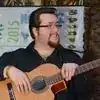
 Nicolas Adams
Nicolas Adams
Professional GuitaristIn the beginning, your fingers might hurt from playing the guitar. If you notice any pain in your fingers, try holding the strings flat instead of at an angle. Lessening the pain in your fingers takes time and practice because your fingers are not naturally callous. You might develop large callouses, but you might not; take care of your hands by using moisturizer.
Mastering the Mechanics
-
1Curl your fingers. If the strings are buzzing or sounding flat, it could be because your fingers are flattening out and touching the strings beside the string you're fretting. Your two finger joints should make something of a box over the neck of the guitar.[10]
- The first finger joint often has the most tendency to flatten out, and can muffle or mute the string next to the one you're fretting.
- To help get your fingers in the right position, think of holding an apple or a tennis ball in your hand with your fingers curled around it. This is how you want your fingers to be on the neck of the guitar – not flat.
- C major and G major are good chords to use to check your finger positioning. Since your fingers are further extended, it can be easier for the knuckles to flatten out.
-
2Stay close to the fret. If the chord isn't sounding right when you compare it to audio files, assuming your guitar is in tune, the problem may be that your fingers aren't close enough to the right fret.[11]
- Generally, you want to try to keep your fingers as close to the fret as possible – but not on the fret.
- In your mind, visualize the space between the frets as divided into quarters. Your finger should be in the lower quarter of this space, and no higher. For example, if you're playing a chord that requires your third finger to the on the second fret, your finger should be about three-quarters down from the first fret, just above the second fret.
-
3Check your pressure on the strings. You don't have to press down too hard on the string to make the note sound. Too much pressure can cause tension and pain in your hand, not to mention injuring the skin on your fingers.[12]
- When you make a chord, you should be applying even pressure on each of the strings that you're fretting. If you're applying too much (or too little) pressure to one of the strings, it can cause the chord to sound off.
-
4Unkink your wrist. Your wrist positioning is in many ways just as important as your finger positioning, especially if you eventually want to learn more advanced guitar chords and techniques such as bar chords or power chords. Make sure your wrist is in a neutral position.[13]
- If you tend to kink your wrist forward in front of the guitar neck, you'll probably experience pain after playing for awhile, and your fingers will have less mobility.
- You also may have the tendency to kink your wrist behind the guitar neck. This may inhibit your ability to get a clean sound from your chords, as well as causing your fingers to flatten.
- Keep in mind that kinking your wrist not only affects your guitar's sound and your ability to position your fingers correctly, it also can damage your wrist and lead to more serious issues such as carpal tunnel syndrome over time. If you plan to play guitar often, find some good wrist strengthening exercises and stretches to help take care of your wrists and prevent such problems.
-
5Maintain good posture. If you aren't sitting (or standing) with good posture, you may have problems positioning your fingers or wrist correctly. Keep your thumb on the guitar to distribute the weight, and make sure your arms and shoulders are relaxed.[14]
- If you're hunched over or crunching your shoulders, you probably also have the tendency to kink your wrist.
- Check your elbows as well. The elbow of your fretting arm should be close to your side, not jutting out away from you. If you have the tendency to jut your elbow out, this may be causing you to hunch over or to kind your wrist.
- At least when you're first learning to play, it's typically a good idea to practice while sitting rather than trying to stand. That way you can balance the bulk of the guitar's weight on your lap rather than hanging from a strap, which can cause you to hunch if you're unaccustomed to the weight.
Making More Chords
-
1Make an E major chord. To finger E major, your second finger will be on the second fret of the A string, your third finger on the second fret of the D string, and your first finger on the first fret of the G string.[15]
- From E major, if you lift your first or index finger off the string and strum, you have an E minor chord. Practice strumming these two chords together by lifting your index finger on every other strum.
-
2Move your fingers over to A minor. With A minor, you use exactly the same finger shape that you used to make E major, but you move your fingers over to a different set of strings. This makes A minor easy to find after you've been practicing E major.[16]
- When you strum A minor, leave the low E string out and only strum the top five strings. You'll strum the same strings for A major as you do for A minor.
-
3Find A major. For A major, your first, second, and third fingers will all be lined up along the second fret of the D, G, and B strings. This finger positioning can be difficult because there isn't much room for your second finger between your first and third.[17]
- You'll find that your first and second fingers can't really be as close to the fret as would be ideal. You'll get more comfortable with practice and be able to stretch your fingers closer to the fret.
- Practicing switching from A major to E major is a good way to practice both chord shapes together. Remember that with E major you're strumming all six strings, while with A major you're only strumming the top five strings.
-
4Learn F major. While there is a more complex version of the F major chord that is a bar chord, you can learn a three-note F major chord that is much simpler. The key difficulty for you in playing the F major chord may be strumming the right strings.[18]
- To make an F major chord, put your first finger on the first fret of the B string, your second finger on the second fret of the G string, and your third finger on the third fret of the D string. You probably recognize this configuration as the same you used for C major, just on different strings.
- When you strum F major, you only want to strum the three strings that you've fretted. Don't strum the low E, A, or high E strings.
-
5Look for more songs to play. Now that you know eight chords, there are hundreds of popular and classic songs you should be able to play. Search online for tabs of songs that you enjoy. Take it slow, concentrating on one song at a time until you get to the point that you can play it without the tab.[19]
- For example, since you know G, F, and C, you can learn Sympathy for the Devil by the Rolling Stones, which uses those three chords.
- There also are a wealth of popular songs that use four chords. In fact, C, A minor, F, and G make up the most popular chord progression for country, rock, and popular music. Note that if you find the F major chord difficult, you can transpose the chords and play G, E minor, C, and D instead.
Community Q&A
-
QuestionHow hard do I have to hold the chords?
 Community AnswerYou only have to use enough pressure on the chords so that the strings are touching the guitar neck.
Community AnswerYou only have to use enough pressure on the chords so that the strings are touching the guitar neck. -
QuestionI'm new and confused. Does a note mean one string? Is each string a different letter?
 Community AnswerThe musical staff isn't supposed to be a picture of the guitar strings. It's used for all music, not just guitars. It's more of a grid to visualize notes. Each line and space on the musical staff represents a note. The fact that some are lines and some are spaces doesn't really mean anything. The idea was to make it easier on the eyes. If you're trying to read one note on a musical staff, that means you should play one string. Sometimes letters written above the staff are for guitar chords, which means a whole set of notes in a certain key. If you want to read music, you should also learn some music theory.
Community AnswerThe musical staff isn't supposed to be a picture of the guitar strings. It's used for all music, not just guitars. It's more of a grid to visualize notes. Each line and space on the musical staff represents a note. The fact that some are lines and some are spaces doesn't really mean anything. The idea was to make it easier on the eyes. If you're trying to read one note on a musical staff, that means you should play one string. Sometimes letters written above the staff are for guitar chords, which means a whole set of notes in a certain key. If you want to read music, you should also learn some music theory.
References
- ↑ http://www.premierguitar.com/articles/19696-digging-deeper-how-many-chords-are-there
- ↑ http://www.cyberfret.com/guitar-chords/7-basic-guitar-chords-for-beginners/
- ↑ http://www.dummies.com/art-center/music/guitar/guitar-all-in-one-for-dummies-cheat-sheet/
- ↑ http://www.dummies.com/art-center/music/guitar/guitar-all-in-one-for-dummies-cheat-sheet/
- ↑ http://www.dummies.com/art-center/music/guitar/guitar-all-in-one-for-dummies-cheat-sheet/
- ↑ http://www.guitarlessons.com/blog/lessons/8-guitar-chords-you-must-know/
- ↑ http://www.guitarlessons.com/blog/lessons/8-guitar-chords-you-must-know/
- ↑ http://www.guitarlessons.com/blog/lessons/8-guitar-chords-you-must-know/
- ↑ http://www.doubleestudios.com/most_excellent_songs/index.html
- ↑ http://www.guitarlessons.com/blog/lessons/8-guitar-chords-you-must-know/
- ↑ http://acousticguitar.com/three-tips-for-playing-chords-cleanly/
- ↑ http://acousticguitar.com/three-tips-for-playing-chords-cleanly/
- ↑ http://www.guitarlessons.com/guitar-lessons/rhythm-guitar-quick-start-series/how-to-play-bar-chords/
- ↑ http://www.guitarlessons.com/blog/lessons/8-guitar-chords-you-must-know/
- ↑ http://www.guitarlessons.com/blog/lessons/8-guitar-chords-you-must-know/
- ↑ http://www.guitarlessons.com/blog/lessons/8-guitar-chords-you-must-know/
- ↑ http://www.guitarlessons.com/blog/lessons/8-guitar-chords-you-must-know/
- ↑ http://www.guitarlessons.com/blog/lessons/8-guitar-chords-you-must-know/
- ↑ http://www.doubleestudios.com/most_excellent_songs/index.html
About This Article
While it’s not necessary to learn every single chord on the guitar, if you practice the basic chords and their variations, you’ll have a strong foundation for your playing. First, try learning the G major chord by placing your third finger on the third fret of the low E string, your second finger on the second fret of the A string, and your fourth finger on the third fret of the high E string. To play the C major chord, put your first finger on the first fret of the B string, your second finger on the second fret of the D string, and your third finger on the third fret of the B string. To play a D major chord, put your third finger on the third fret of the B string, your second finger on the second fret of the high E string, and your first finger on the second fret of the G string. With just these 3 chords you can play tons of songs, such as Small Town by Jack and Diane and Already Gone by the Eagles. To learn how to play other chords, read on!

